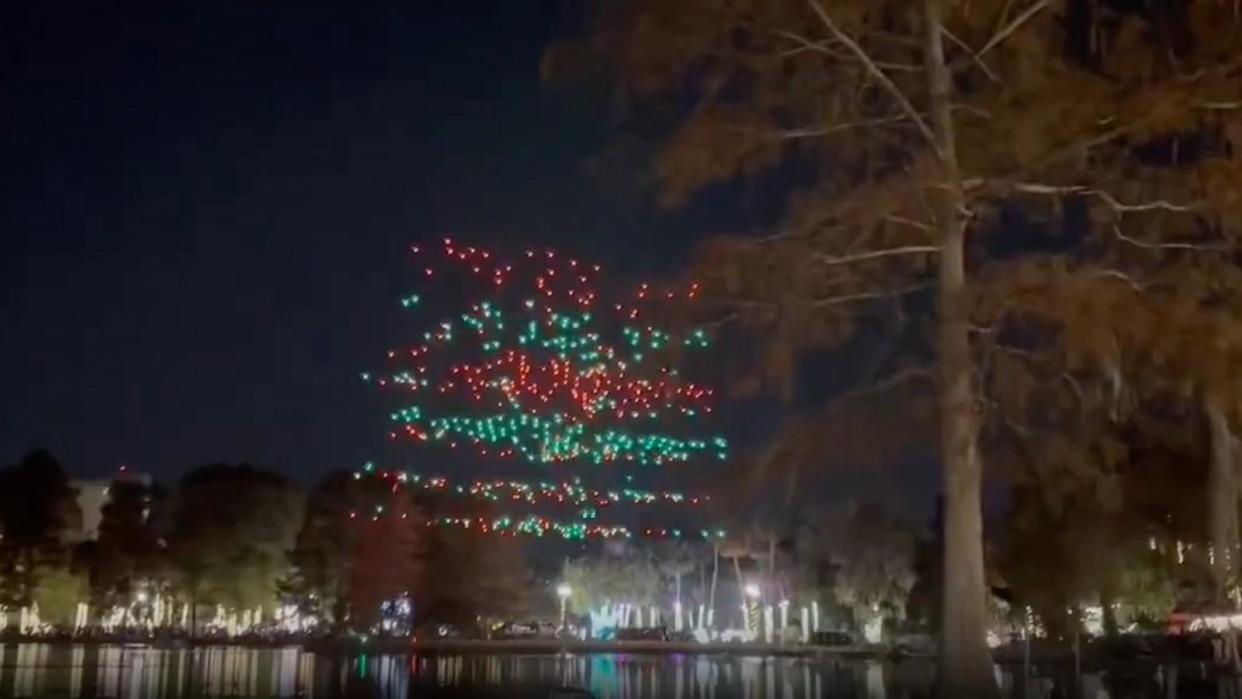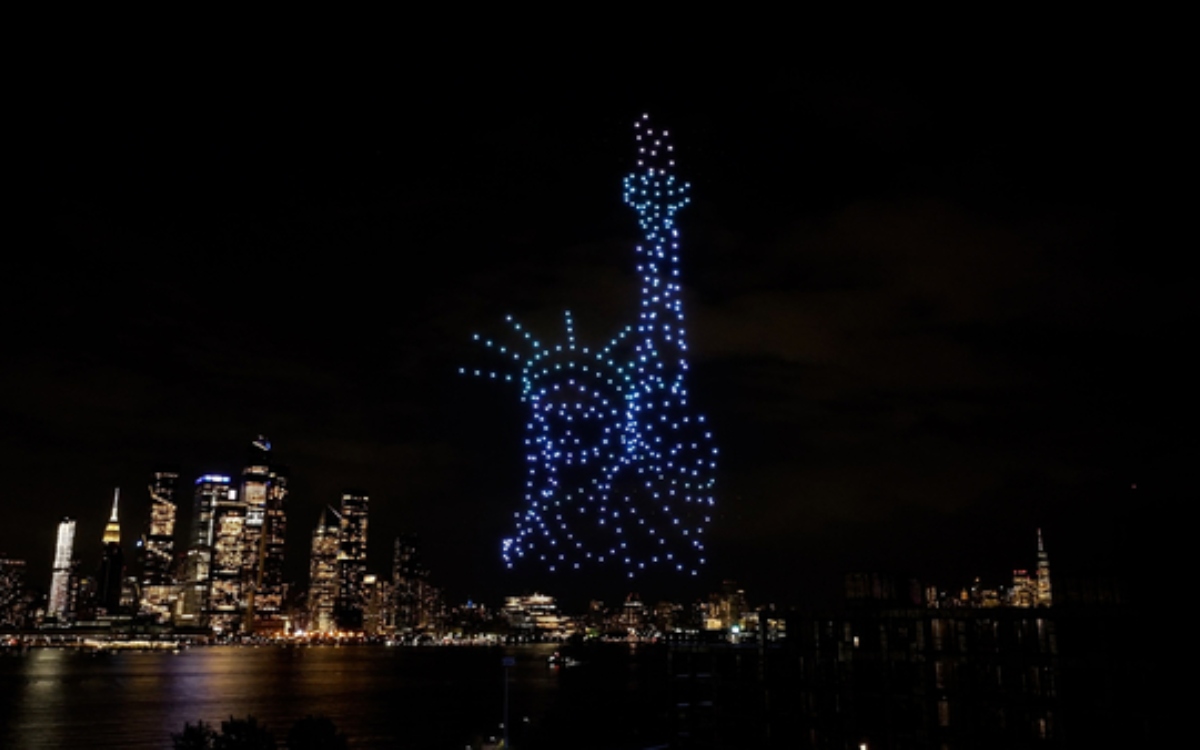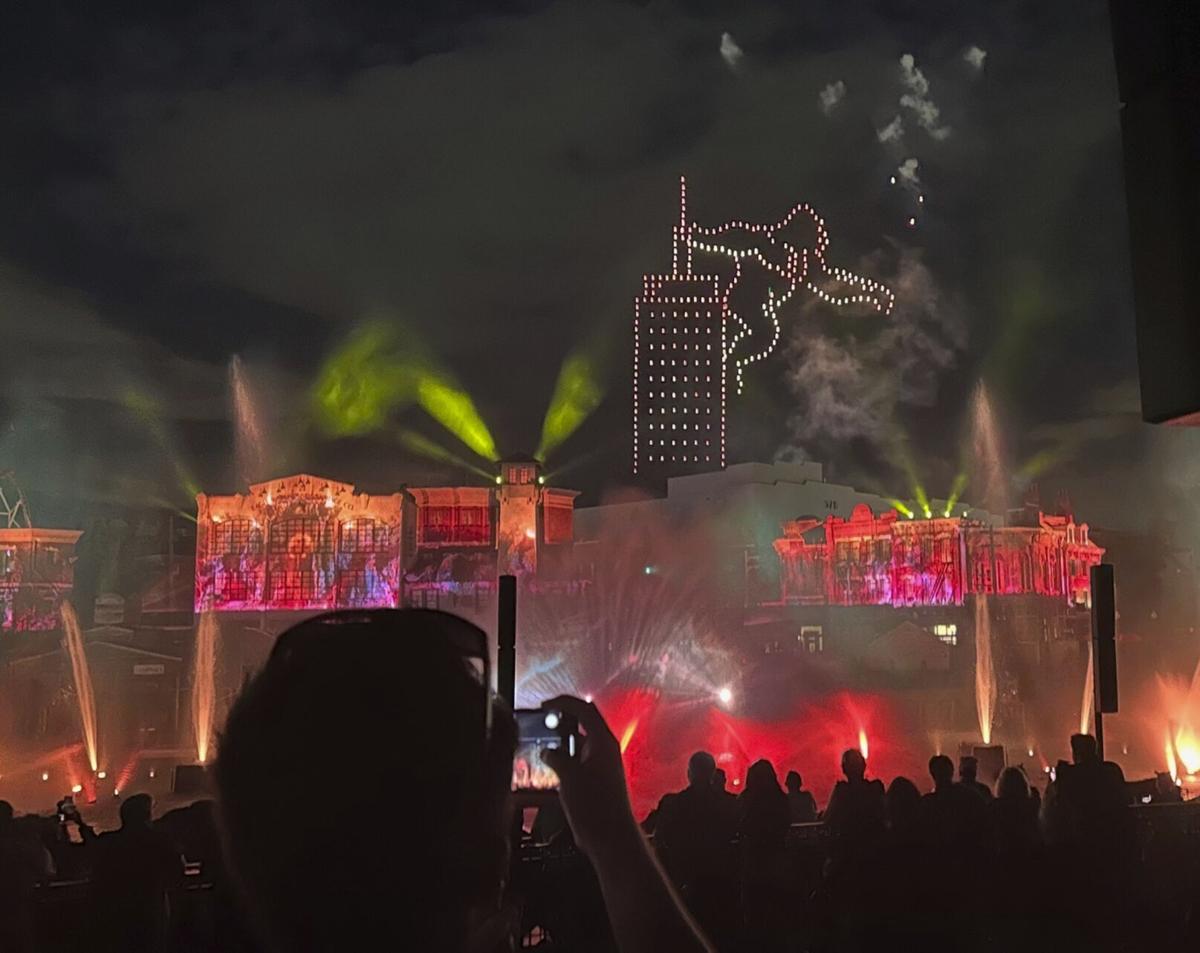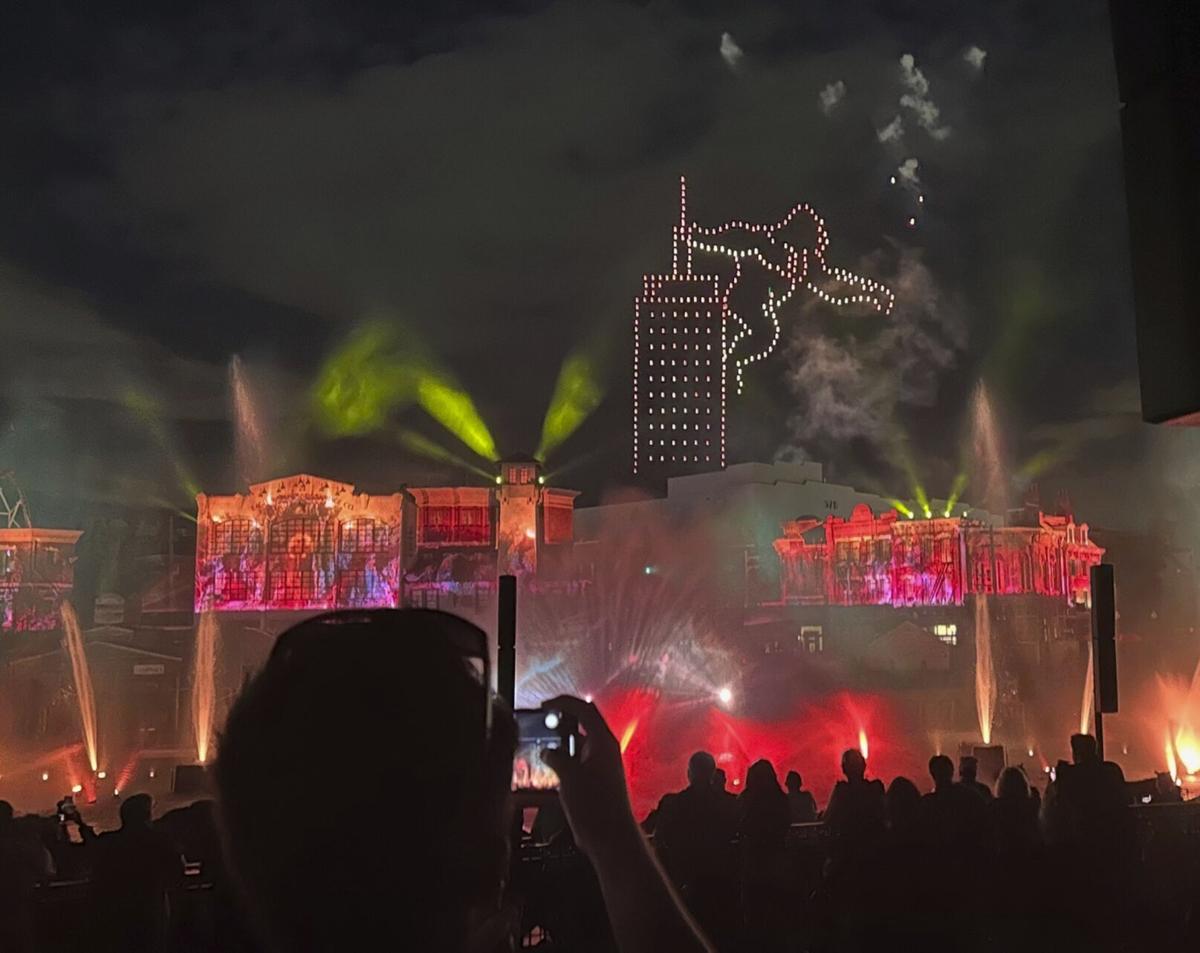Orlando drone show accident: A spectacular light show turned unexpectedly dramatic. This incident raises crucial questions about safety regulations, technological reliability, and human error in the burgeoning drone entertainment industry. We’ll explore the accident’s details, analyze contributing factors, and examine how future tragedies might be prevented.
The investigation into the Orlando drone show accident is multifaceted, encompassing a detailed examination of the drones’ technical specifications, the operators’ adherence to safety regulations, and a thorough analysis of potential human errors. Understanding these factors is key to improving safety protocols and preventing similar accidents in the future.
Accident Details

The Orlando drone show accident, while thankfully resulting in no serious injuries, highlighted potential safety concerns within large-scale drone light shows. The incident involved a malfunction during a pre-programmed sequence, leading to several drones deviating from their intended flight paths. This underscores the need for robust safety protocols and redundancy systems in such performances.The accident involved a fleet of approximately 500 small, commercially available quadcopter drones.
These drones, while not individually specified by model in public reports, were likely similar in design and capabilities to many commonly used in drone light shows. They were equipped with LED lights of various colors to create the visual effects of the show. The drones’ precise specifications, including battery life, range, and onboard processing power, remain largely undisclosed in official statements following the incident.
Timeline of Events
The drone show commenced without incident, proceeding through several planned sequences. Approximately halfway through the performance, a noticeable glitch occurred. Several drones began exhibiting erratic flight patterns, drifting away from the main formation. This deviation escalated rapidly, with a significant number of drones becoming disoriented and colliding with each other. The show was immediately halted, and emergency protocols were initiated to regain control of the remaining drones and secure the area.
Post-accident investigations focused on analyzing flight data logs from the surviving drones and reviewing the show’s programming to identify the root cause of the malfunction.
Immediate Aftermath
The immediate aftermath saw a flurry of activity to ensure public safety. The area was secured, and emergency personnel were dispatched to assess the situation. No serious injuries were reported, though some minor property damage was observed. Several drones were damaged beyond repair due to the collisions, while others were recovered and examined as part of the subsequent investigation.
Hey, so you heard about that crazy Orlando drone show accident, right? It’s a pretty wild story, and if you want the full lowdown, check out this article detailing the incident: orlando drone show accident. Seriously, the details are pretty shocking; it really highlights the potential risks involved in large-scale drone operations. The Orlando drone show accident is a great example of why safety protocols are so crucial.
The event organizers cooperated fully with authorities, and a thorough review of safety procedures and technology was undertaken to prevent similar incidents in the future.
Regulatory Compliance
The Orlando drone show accident necessitates a thorough examination of the regulatory framework governing drone operations and an assessment of whether the operators complied with established safety guidelines. Failure to adhere to these regulations can have severe consequences, as tragically demonstrated by this incident. This section will detail relevant regulations, analyze the operators’ adherence, and identify potential violations.
Drone operations in the United States, and specifically within Orlando, Florida, are subject to a complex web of regulations primarily overseen by the Federal Aviation Administration (FAA). These regulations cover various aspects, including pilot certification, drone registration, airspace limitations, operational procedures, and safety protocols. Key regulations relevant to large-scale drone shows like the one in Orlando include Part 107 of the FAA regulations, which Artikels the rules for commercial drone operations, and any local ordinances or airport restrictions that may apply.
FAA Part 107 Compliance
Part 107 of the FAA regulations sets forth specific requirements for commercial drone pilots, including holding a Remote Pilot Certificate, maintaining operational awareness, adhering to visual line-of-sight limitations, and operating within specified airspace restrictions. Determining whether the Orlando drone show operators fully complied with Part 107 requires a detailed investigation into their pilot certifications, flight plans, and adherence to operational procedures.
Potential violations could include operating outside of visual line of sight, failing to obtain necessary airspace authorizations, or neglecting pre-flight inspections. For instance, a failure to account for unexpected wind conditions, a common violation, could be a contributing factor.
Airspace Authorization and Coordination
Before any drone show can take place, especially in an area with potentially complex airspace like Orlando, operators are required to obtain the necessary airspace authorizations from the FAA and coordinate with other airspace users, including airports and air traffic control. Failure to secure these authorizations or properly coordinate flight plans could result in a dangerous situation, increasing the risk of mid-air collisions.
The investigation into the Orlando accident needs to determine whether all necessary authorizations were obtained and whether effective communication with relevant authorities occurred. A failure to do so could constitute a significant regulatory violation.
Comparison with Similar Drone Shows
The safety protocols employed in the Orlando drone show should be compared to those used in similar large-scale drone shows across the country and internationally. This comparative analysis would identify best practices and highlight areas where the Orlando show might have fallen short. For example, were redundant systems in place to prevent failures? Were sufficient safety personnel deployed?
Were emergency protocols adequately tested and practiced? Such comparisons can provide valuable insights into potential areas for improvement in drone show safety regulations and operational procedures. Analyzing shows with flawless safety records, such as those held in major cities known for their advanced drone show technology, will offer a baseline for comparison.
Technical Aspects
The Orlando drone show accident highlights the critical role of technical reliability in large-scale drone operations. Understanding the potential points of failure within the drone’s systems is crucial for preventing future incidents. This section will explore the technical malfunctions that could have contributed to the accident, examining both the drone’s hardware and software components.
Several technical malfunctions could have independently or collectively led to the accident. These range from simple component failures to more complex software glitches or communication disruptions. The intricate interplay of various systems within a drone makes pinpointing a single cause challenging, often necessitating a thorough investigation.
Drone Flight Control Systems and Potential Points of Failure
A drone’s flight control system is a complex network of sensors, processors, and actuators working in concert. Potential points of failure include the GPS receiver, IMU (Inertial Measurement Unit), flight controller, and motor controllers. A GPS failure, for example, could result in the drone losing its positional awareness, leading to erratic flight. Similarly, an IMU malfunction could cause inaccurate readings of the drone’s orientation and velocity, also resulting in uncontrolled movement.
Failures in the flight controller, the “brain” of the drone, could manifest in various ways, from complete loss of control to unintended maneuvers. Finally, motor controller failures could cause individual motors to malfunction, leading to instability and a potential crash.
Hypothetical Scenario of Technical Failures, Orlando drone show accident
Imagine a scenario where a GPS signal is intermittently lost due to interference from other radio signals or atmospheric conditions during the Orlando drone show. This intermittent loss causes the drone’s flight controller to rely more heavily on its IMU for position estimation. However, a slight drift in the IMU’s readings, perhaps due to sensor noise or temperature fluctuations, leads to accumulating errors in the drone’s position calculation.
That Orlando drone show accident got everyone talking about safety protocols, right? It makes you wonder about the bigger picture of drone regulation, especially considering incidents like the recent mystery drone Paris situation. That whole thing raised a lot of questions about unauthorized drone flights and potential security risks, which are definitely relevant when thinking about how to prevent future Orlando-style mishaps.
This error, compounded by a momentary power surge affecting one motor controller, results in a sudden imbalance in the drone’s thrust. The drone, now struggling to maintain stability due to the combined failures, veers off course and crashes. This hypothetical scenario demonstrates how a chain of seemingly minor technical issues can culminate in a catastrophic event.
Comparison to Industry Standards for Safety and Reliability
The drone’s software and hardware should adhere to rigorous industry standards for safety and reliability. These standards often include redundancy in critical systems (e.g., multiple GPS receivers, backup flight controllers), robust error detection and correction mechanisms, and rigorous testing procedures. The specifics of these standards vary depending on the drone’s application and regulatory environment. For example, drones used in critical infrastructure inspections often have higher safety requirements compared to those used for recreational purposes.
That Orlando drone show accident really got people talking about drone safety, huh? It makes you wonder about the logistics of large-scale drone operations, especially considering places like amazon drone delivery locations , which are constantly expanding. Thinking about those delivery routes and the potential for similar incidents highlights the importance of robust safety protocols for all drone operations, big or small, to prevent future accidents.
A comparison of the drone’s design and operational procedures against relevant industry best practices, such as those Artikeld by organizations like the FAA or ASTM International, would be necessary to assess whether the drone met the expected level of safety and reliability. Deviations from these standards could indicate areas needing improvement in design, manufacturing, or operation.
Human Factors

Human error plays a significant role in many drone accidents. Understanding these errors is crucial for improving safety protocols and preventing future incidents. This section will explore potential human factors that might have contributed to the Orlando drone show accident, examining pilot training, communication, and coordination among the operators.Potential Human Errors in Drone Operation
Pilot Training and Certification
Adequate pilot training is paramount for safe drone operation. This includes not only the technical skills of flying the drone but also understanding airspace regulations, emergency procedures, and risk assessment. The level of certification required varies depending on the complexity of the operation and the type of drone used. For large-scale drone shows like the one in Orlando, highly specialized training, encompassing complex choreography, flight planning in challenging environments, and redundant systems management, is essential.
Examples of relevant training might include FAA Part 107 certification (for standard operations) supplemented by advanced training courses focusing on multi-drone operations and complex flight maneuvers. A lack of proper training, insufficient experience with the specific drone model used, or inadequate preparation for unexpected events could significantly increase the risk of accidents.
Communication and Coordination
Effective communication and coordination are vital, particularly in complex operations involving multiple drones. Real-time communication channels, such as dedicated radio frequencies or secure digital communication systems, are necessary to allow operators to share information, coordinate movements, and respond quickly to unexpected situations. A breakdown in communication, whether due to technical issues, insufficient protocols, or human error, could lead to collisions or other accidents.
For instance, a failure to clearly communicate flight paths or to react effectively to an emergency situation among multiple pilots could have catastrophic consequences.
Human Factors Table
| Factor | Description | Impact | Mitigation Strategy |
|---|---|---|---|
| Inadequate Pilot Training | Insufficient training on the specific drone model, complex flight maneuvers, or emergency procedures. | Increased risk of errors in flight control, leading to collisions or loss of control. | Mandatory advanced training programs specific to multi-drone shows, including simulator training and practical exercises. Regular proficiency checks and refresher courses. |
| Poor Communication | Lack of clear communication channels or protocols between operators, resulting in miscommunication or delayed responses to emergencies. | Increased risk of mid-air collisions due to conflicting flight paths or inability to coordinate responses to unexpected events. | Implementation of robust communication systems (e.g., dedicated radio frequencies, secure digital links). Development of clear communication protocols and emergency response plans. Regular communication drills. |
| Fatigue or Stress | Physical or mental fatigue among operators due to long working hours or high-pressure situations. | Impaired judgment and reaction time, leading to increased risk of errors. | Implementing strict rest periods and shift rotations for operators. Providing adequate support and resources to manage stress. |
| Lack of Situational Awareness | Failure to accurately assess the surrounding environment and potential hazards, such as obstacles or other aircraft. | Increased risk of collisions or other accidents. | Use of advanced sensor systems (e.g., obstacle avoidance technology). Implementation of robust risk assessment protocols and pre-flight checks. |
Safety Improvements
The Orlando drone show accident highlights the urgent need for enhanced safety protocols and technological advancements within the burgeoning drone entertainment industry. A multi-pronged approach, encompassing improved regulations, technological upgrades, and refined emergency response procedures, is crucial to preventing future incidents. This section Artikels specific recommendations to bolster drone show safety.
Implementing these improvements requires a collaborative effort between drone operators, regulatory bodies, and technology developers. The goal is to minimize risk, enhance public safety, and ensure the responsible growth of drone light shows.
Improved Drone Redundancy Systems
Redundancy is paramount in any safety-critical system. Current drone systems should incorporate multiple layers of redundancy to mitigate the risk of single-point failures. This includes backup power systems, flight controllers, and communication links. For example, a system might employ two independent GPS modules, with each capable of independently guiding the drone. If one fails, the other seamlessly takes over, preventing a sudden loss of control.
This principle extends to other critical components, ensuring that the failure of one part does not compromise the entire system.
Enhanced Geo-fencing and No-Fly Zone Technology
Precise geo-fencing and sophisticated no-fly zone technologies are essential. These systems should utilize advanced mapping and real-time data to dynamically adjust boundaries based on weather conditions, air traffic, and other potential hazards. The system should be capable of preventing drones from entering restricted airspace, automatically halting operations if an unexpected obstacle is detected. For instance, real-time weather data integration would automatically ground the drone fleet in case of high winds or inclement weather.
Advanced Sensor Integration and Obstacle Avoidance
Advanced sensor systems, including lidar, radar, and computer vision, are critical for obstacle avoidance. These sensors should be integrated to create a comprehensive situational awareness system, allowing drones to autonomously navigate complex environments and avoid collisions with unexpected objects such as birds, buildings, or other aircraft. The data from these sensors should be fused and processed by sophisticated algorithms to ensure accurate and reliable obstacle detection and avoidance.
A real-world example is the use of lidar to create a 3D map of the airspace, allowing the drones to identify and avoid obstacles even in low-light conditions.
Improved Emergency Response Procedures
Effective emergency response protocols are crucial for mitigating the impact of accidents. These protocols should include pre-planned procedures for handling various emergencies, such as loss of communication, drone malfunction, or unexpected weather conditions. Dedicated emergency response teams should be trained to quickly and effectively address incidents, minimizing potential harm to people and property. This training should include specialized techniques for recovering malfunctioning drones and managing the aftermath of an accident.
A well-defined chain of command and clear communication channels are essential for effective response.
Regulatory Compliance and Operator Training
Stringent regulatory compliance and comprehensive operator training are fundamental. Regulations should mandate the use of redundant systems, advanced sensor technologies, and rigorous safety protocols. Operators should undergo extensive training covering emergency procedures, risk assessment, and best practices. Regular inspections and audits should ensure that all operators and equipment meet the required safety standards. For instance, a mandatory certification program for drone show operators could be implemented, requiring them to demonstrate proficiency in safety procedures and operational skills.
Public Perception and Impact

The Orlando drone show accident, while a relatively isolated incident, generated significant public attention and sparked a widespread discussion about the safety and regulation of drone shows. The immediate reaction was a mixture of shock, concern for potential injuries, and questions about the technology’s reliability. This initial wave of public sentiment significantly influenced the subsequent media coverage and regulatory responses.The accident’s impact extended beyond immediate reactions, shaping the long-term perception of drone shows and influencing future developments within the industry.
News outlets, social media, and online forums provided various perspectives, ranging from critical analyses of safety protocols to discussions about the potential benefits and risks of this emerging entertainment technology. The narrative shifted from initial awe and excitement surrounding drone light shows to a more cautious assessment of their potential hazards.
Media Coverage and Public Discourse
News reports following the accident varied in their tone and focus. Some emphasized the spectacular nature of the malfunction, highlighting the dramatic visuals of the falling drones. Others focused on the potential for injury and the lack of apparent safety measures, leading to calls for stricter regulations. Social media platforms became hubs for public discussion, with many users expressing concerns about safety, accountability, and the need for improved oversight.
The accident fueled debates about the balance between technological innovation and public safety, with some advocating for a temporary moratorium on large-scale drone shows until improved safety protocols could be implemented. Examples of media coverage included articles in major newspapers and news websites, as well as discussions on television news programs, many of which showcased footage of the accident itself.
Long-Term Impact on the Drone Show Industry
The Orlando accident served as a significant setback for the rapidly growing drone show industry. The immediate aftermath saw a decrease in bookings for large-scale events, as organizers and clients became more hesitant about the potential risks. Insurance premiums for drone show operators likely increased, reflecting the heightened perception of risk. Furthermore, the accident prompted a reassessment of safety protocols and operational procedures within the industry.
Many companies invested in improved safety technologies and training programs, aiming to regain public trust and demonstrate a commitment to safety. The accident also led to a more rigorous scrutiny of drone show permits and approvals by regulatory bodies. Similar to the impact of major airline accidents, this incident could cause a long-term shift towards greater safety consciousness within the industry, potentially slowing down the rate of expansion until a new level of safety and public confidence is achieved.
Effects on Public Trust and Future Regulations
The Orlando drone show accident had several tangible effects on public trust and influenced the direction of future regulations.
- Erosion of Public Trust: The accident understandably damaged public trust in the safety of drone shows, leading to increased skepticism and a demand for greater transparency and accountability from drone show operators.
- Increased Regulatory Scrutiny: Regulatory bodies responded by implementing stricter safety guidelines and conducting more thorough inspections of drone show operations. This includes more stringent requirements for pilot training, drone maintenance, and emergency response protocols.
- Heightened Insurance Costs: Insurance companies reassessed the risks associated with drone shows, resulting in higher premiums for operators and potentially increasing the cost of staging these events.
- Technological Advancements in Safety: The accident spurred innovation in safety technologies, with companies developing new systems for drone failure detection, autonomous landing capabilities, and improved communication protocols.
- Public Awareness Campaigns: The industry responded by launching public awareness campaigns to educate the public about safety measures implemented to mitigate risks and improve public perception of drone shows.
Illustrative Example
Let’s consider a plausible scenario contributing to a drone show accident. This example highlights potential technical and environmental factors that could lead to a catastrophic failure. The scenario emphasizes the importance of rigorous pre-flight checks and contingency planning.This particular scenario involves a multi-drone light show during a nighttime event. The drones, programmed to perform a complex synchronized routine, experience a cascading failure due to a combination of factors.
Drone System Failure Sequence
The initial failure begins with a malfunction in the primary communication link between one drone and the ground control station. This could be caused by radio frequency interference from other electronic devices operating on the same frequency or a temporary loss of signal due to obstructions like tall buildings or unexpected atmospheric conditions. This drone, unable to receive instructions, begins to deviate from its programmed flight path.
Visual cues such as erratic movements and a noticeable dimming of its lights might have alerted a trained observer. Auditory cues would likely be absent, as most drones are electrically powered and relatively quiet in operation. However, a sudden change in the drone’s motor sound could have been an indicator.
Environmental Factors Influencing Drone Performance
The environmental conditions during the show played a significant role in the accident’s severity. The wind speed was unexpectedly high, exceeding the drones’ specified operational limits. This resulted in increased stress on the drone’s airframe and motors. Visibility was good, but the strong winds made precise flight control more challenging. The ambient light levels were low, creating a scenario where the human operators had less visual feedback from the drones, further compounding the issue of identifying the malfunctioning drone.
The low light coupled with the high wind made it difficult to visually assess the drone’s stability and position. Imagine a situation where the wind is gusting at 20 mph, causing significant drift and making it hard for the operators to react effectively. This is a real-world scenario that has caused problems in similar outdoor events.
Consequences of the Initial Failure
The initial communication failure and the high winds created a domino effect. The malfunctioning drone, buffeted by the wind, collided with another drone in the formation. This secondary collision triggered a cascade, causing further collisions and ultimately resulting in several drones crashing to the ground. The lack of sufficient redundancy in the drone’s control system exacerbated the problem, as there was no backup communication channel or automated fail-safe mechanism to prevent the collision.
The high density of drones in the show further amplified the risk of a cascading failure.
Last Word
The Orlando drone show accident serves as a stark reminder of the inherent risks involved in large-scale drone operations. While technological advancements offer incredible possibilities, robust safety regulations, rigorous pilot training, and a proactive approach to risk mitigation are paramount to ensure the responsible and safe development of the drone entertainment industry. Only through a comprehensive understanding of this incident and the implementation of effective preventative measures can we hope to avoid similar tragedies in the future.
FAQ Insights: Orlando Drone Show Accident
What type of drones were involved?
This information will be detailed in the accident report once available. The specific model and manufacturer are crucial details to the investigation.
Were there any witnesses?
The extent of witness accounts and their statements will likely be part of the official investigation. Their testimonies will help piece together the timeline of events.
What is the expected timeline for the investigation?
Investigations of this nature can take several months, depending on the complexity of the accident and the amount of data to be analyzed.
What was the estimated cost of damages?
The financial impact, including damage to property and potential legal repercussions, will be determined later in the investigation and any subsequent legal proceedings.
